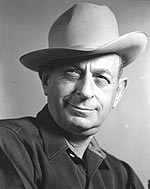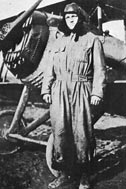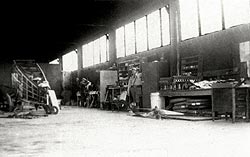|  |   |  Former 'Contrabandista' Using Confiscated Aircraft Started Rogue Customs Air Brigade
(01/04/2010) CBP’s rogue air brigade is a story from which legends are made. It all began in 1931. A rundown plane, pieced together by wire, was apprehended by mounted inspectors just southeast of Cotulla, Texas. Inspectors seized the cargo, and eyeing the plane, the idea for an air brigade was born. CBP’s rogue air brigade is a story from which legends are made. It all began in 1931. A rundown plane, pieced together by wire, was apprehended by mounted inspectors just southeast of Cotulla, Texas. Inspectors seized the cargo, and eyeing the plane, the idea for an air brigade was born. |  | click for hi-res
 | | Alvin “Al” Freidheim Scharff. |
| |
Photo Credit: U.S. Customs and Border Protection historical collections |
|
|  |  |
It took Alvin “Al” Freidheim Scharff (1892-1968), San Antonio’s Customs agent-in-charge, to actually make the notion of using seized airplanes to create an unofficial air brigade a reality.Al Scharff was an unlikely choice for a Customs agent. He had been a so-called contrabandista along the U.S. southern border, with roots as a smuggler, cattle rustler, and peddler of counterfeit pesos. Yet the reformed Scharff worked his way through the ranks. From 1919 to 1961, Scharff served with the Customs Service as inspector, mounted inspector, special agent, special agent-in-charge, and supervising special agent-in-charge.By late 1931, Scharff with the encouragement of Supervising Customs Agent Harry Creighton pursued a suitable cast of daring agents to take on the adventure of intercepting smugglers by air. Drue Conner, an agent from San Francisco, along with Texas Rangers Suggs Cummings and Tim Oden, and a new addition to the force, Bobby Deuel, were placed in charge of border operations dealing with drug and alcohol smuggling. The group carved out narrow landing strips at strategic points along air-smuggler’s routes, covered their planes with mesquite brush to conceal themselves from aerial view, and waited for information on incoming cargo. |  | click for hi-res
 | | Two Curtiss Falcons and a Waco, showing improvised U.S. Customs seals & flag, outside hangar at Dodd Field, Fort Sam Houston, San Antonio, Texas. |
| |
Photo Credit: U.S. Customs and Border Protection historical collections |
|
|  |  |
In May 1932, Agents Conner and Cummings chased down an unlikely rum runner, former World War ace Lieutenant William Thomas Ponder. Ponder had experience on his side having served with the French Aviation Service’s Lafayette Flying Corps before transferring to the United States Army Air Service in 1918. | 
| | |
Photo Credit: American Aces of World War 1, Osprey Publishing, private collection. |
|
|  |  |
For his service during the War, Ponder received the Distinguished Service Cross and Croix de Guerre for “breaking up an enemy attack of 13 planes on a lone American flyer near Fontaines, France in October 1918.” However in 1932, as Ponder crossed into Texas from Mexico with his illegal cargo, he was unable to shake off Agents Conner and Cummings. The 200 mile chase from the Mexican border to San Antonio “marked the first airplane seizure where both the government and the hunted craft were in the air.”The number of aircraft seizures by Scharff’s brigade grew immensely in 1932. So much so, that the U.S. Army at Dodd Field, Fort Sam Houston, near San Antonio, offered their assistance by providing parts, materials, and an old hanger for the makeshift Customs air brigade. Scharff and his brigade were so effective in stemming smuggling activities that Washington could no longer ignore the operation. On March 9, 1934, Treasury Secretary Henry Morgenthau directed that “all flying activities of the Treasury Department be consolidated under the cognizance of one organization,” the U.S. Coast Guard.  |  | click for hi-res
 | | Interior of Customs hangar at Dodd Field, Fort Sam Houston, San Antonio, Texas. A uniformed Customs Patrol Inspector stands in center. |
| |
Photo Credit: U.S. Customs and Border Protection historical collections |
|
|  |  |
The news was no doubt a disappointment to Agent-in-Charge Scharff, though the setback was mitigated by the induction of four Customs pilots into the Coast Guard as chief petty officer aviation pilots. In 1937, Morgenthau placed Scharff in control of anti-narcotics operations in Europe, a position he held until 1938 when he returned to Texas to serve as agent-in-charge in Houston. Scharff was promoted to supervising agent-in-charge in 1943. In 1961, he was forced to retire at the Customs mandatory age of 70.Despite Scharff’s questionable background, he had numerous successes. What remains clear about Scharff was his effectiveness along the southern border. This sentiment was shared by former Commissioner of Customs Philip Nichols, Jr. Though Nichols applauded Scharff’s work, he clearly acknowledged that “another Al Scharff could not possibly be admitted into the Service today.”It was not until 1968 that Scharff’s idea was truly realized with the creation of an air program under CBP’s legacy Customs Service. |
 |
|  |  |  |
|